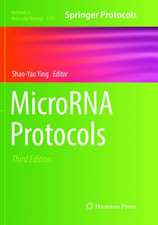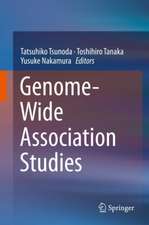Crossover: Concepts and Applications in Genetics, Evolution, and Breeding: An Interactive Computer-Based Laboratory Manual
Autor Jack E. Stauben Limba Engleză Paperback – 14 feb 1994
Crossover is a laboratory manual and computer program that work together to teach the principles of genetics. Designed to complement regular textbooks and classroom instruction, Crossover consists of thirty-five modules that can be tailored to fit genetics courses at several levels. Examples, interactive computer models, problems, and self-tests all help students understand difficult concepts and learn the basic mathematical skills needed to study contemporary theories of genetics, evolution, and breeding. The easy-to-use tutorial system lets students work at their own pace.
Features include:
• In-depth investigations of meiosis, genetic ratios, linkage mutation, natural selection, Hardy-Weinberg equilibrium, artificial selection, quantitative genetics, breeding methods, mating designs, plant patent law, and the use of molecular markers
• A computer model that allows students to manipulate genetic parameters and compare outcomes. Students can observe evolution and artificial selection in action
• A “Major Concepts” section at the beginning of each chapter to help students focus on the important material to be learned
• A visual, easy-to-understand presentation of material
• Exercises based on genetic data and analyses from actual research projects
• Several stages of complexity within each area of instruction.
• Instant grading of exercises
• “Suggested Readings” at the end of each chapter to direct the student to related books, articles, and computer programs.
Features include:
• In-depth investigations of meiosis, genetic ratios, linkage mutation, natural selection, Hardy-Weinberg equilibrium, artificial selection, quantitative genetics, breeding methods, mating designs, plant patent law, and the use of molecular markers
• A computer model that allows students to manipulate genetic parameters and compare outcomes. Students can observe evolution and artificial selection in action
• A “Major Concepts” section at the beginning of each chapter to help students focus on the important material to be learned
• A visual, easy-to-understand presentation of material
• Exercises based on genetic data and analyses from actual research projects
• Several stages of complexity within each area of instruction.
• Instant grading of exercises
• “Suggested Readings” at the end of each chapter to direct the student to related books, articles, and computer programs.
Preț: 206.25 lei
Preț vechi: 217.11 lei
-5% Nou
Puncte Express: 309
Preț estimativ în valută:
39.47€ • 42.86$ • 33.16£
39.47€ • 42.86$ • 33.16£
Carte tipărită la comandă
Livrare economică 23 aprilie-07 mai
Preluare comenzi: 021 569.72.76
Specificații
ISBN-13: 9780299135645
ISBN-10: 0299135640
Pagini: 384
Dimensiuni: 216 x 279 x 28 mm
Greutate: 0.94 kg
Editura: University of Wisconsin Press
Colecția University of Wisconsin Press
ISBN-10: 0299135640
Pagini: 384
Dimensiuni: 216 x 279 x 28 mm
Greutate: 0.94 kg
Editura: University of Wisconsin Press
Colecția University of Wisconsin Press
Descriere
Crossover is a laboratory manual and computer program that work together to teach the principles of genetics. Designed to complement regular textbooks and classroom instruction, Crossover consists of thirty-five modules that can be tailored to fit genetics courses at several levels. Examples, interactive computer models, problems, and self-tests all help students understand difficult concepts and learn the basic mathematical skills needed to study contemporary theories of genetics, evolution, and breeding. The easy-to-use tutorial system lets students work at their own pace.
Features include:
• In-depth investigations of meiosis, genetic ratios, linkage mutation, natural selection, Hardy-Weinberg equilibrium, artificial selection, quantitative genetics, breeding methods, mating designs, plant patent law, and the use of molecular markers
• A computer model that allows students to manipulate genetic parameters and compare outcomes. Students can observe evolution and artificial selection in action
• A “Major Concepts” section at the beginning of each chapter to help students focus on the important material to be learned
• A visual, easy-to-understand presentation of material
• Exercises based on genetic data and analyses from actual research projects
• Several stages of complexity within each area of instruction.
• Instant grading of exercises
• “Suggested Readings” at the end of each chapter to direct the student to related books, articles, and computer programs.
Features include:
• In-depth investigations of meiosis, genetic ratios, linkage mutation, natural selection, Hardy-Weinberg equilibrium, artificial selection, quantitative genetics, breeding methods, mating designs, plant patent law, and the use of molecular markers
• A computer model that allows students to manipulate genetic parameters and compare outcomes. Students can observe evolution and artificial selection in action
• A “Major Concepts” section at the beginning of each chapter to help students focus on the important material to be learned
• A visual, easy-to-understand presentation of material
• Exercises based on genetic data and analyses from actual research projects
• Several stages of complexity within each area of instruction.
• Instant grading of exercises
• “Suggested Readings” at the end of each chapter to direct the student to related books, articles, and computer programs.



























